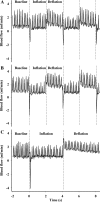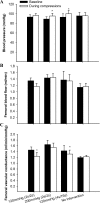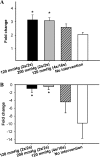Intermittent pneumatic leg compressions acutely upregulate VEGF and MCP-1 expression in skeletal muscle
- PMID: 20348224
- PMCID: PMC2886650
- DOI: 10.1152/ajpheart.00006.2010
Intermittent pneumatic leg compressions acutely upregulate VEGF and MCP-1 expression in skeletal muscle
Abstract
Application of intermittent pneumatic compressions (IPC) is an extensively used therapeutic strategy in vascular medicine, but the mechanisms by which this method works are unclear. We tested the hypothesis that acute application (150 min) of cyclic leg compressions in a rat model signals upregulation of angiogenic factors in skeletal muscle. To explore the impact of different pressures and frequency of compressions, we divided rats into four groups as follows: 120 mmHg (2 s inflation/2 s deflation), 200 mmHg (2 s/2 s), 120 mmHg (4 s/16 s), and control (no intervention). Blood flow and leg oxygenation (study 1) and the mRNA expression of angiogenic mediators in the rat tibialis anterior muscle (study 2) were assessed after a single session of IPC. In all three groups exposed to the intervention, a modest hyperemia (approximately 37% above baseline) between compressions and a slight, nonsignificant increase in leg oxygen consumption (approximately 30%) were observed during IPC. Compared with values in the control group, vascular endothelial growth factor (VEGF) and monocyte chemotactic protein-1 (MCP-1) mRNA increased significantly (P < 0.05) only in rats exposed to the higher frequency of compressions (2 s on/2 s off). Endothelial nitric oxide synthase, matrix metalloproteinase-2, and hypoxia-inducible factor-1alpha mRNA did not change significantly following the intervention. These findings show that IPC application augments the mRNA content of key angiogenic factors in skeletal muscle. Importantly, the magnitude of changes in mRNA expression appeared to be modulated by the frequency of compressions such that a higher frequency (15 cycles/min) evoked more robust changes in VEGF and MCP-1 compared with a lower frequency (3 cycles/min).
Figures





Similar articles
-
Intermittent pneumatic leg compressions enhance muscle performance and blood flow in a model of peripheral arterial insufficiency.J Appl Physiol (1985). 2012 May;112(9):1556-63. doi: 10.1152/japplphysiol.01337.2011. Epub 2012 Feb 23. J Appl Physiol (1985). 2012. PMID: 22362398 Free PMC article.
-
Impact of a single session of intermittent pneumatic leg compressions on skeletal muscle and isolated artery gene expression in rats.Am J Physiol Regul Integr Comp Physiol. 2011 Dec;301(6):R1658-68. doi: 10.1152/ajpregu.00457.2011. Epub 2011 Sep 28. Am J Physiol Regul Integr Comp Physiol. 2011. PMID: 21957157 Free PMC article.
-
Acute impact of intermittent pneumatic leg compression frequency on limb hemodynamics, vascular function, and skeletal muscle gene expression in humans.J Appl Physiol (1985). 2012 Jun;112(12):2099-109. doi: 10.1152/japplphysiol.00042.2012. Epub 2012 Mar 22. J Appl Physiol (1985). 2012. PMID: 22442025 Free PMC article. Clinical Trial.
-
The critical role of VEGF in skeletal muscle angiogenesis and blood flow.Biochem Soc Trans. 2011 Dec;39(6):1556-9. doi: 10.1042/BST20110646. Biochem Soc Trans. 2011. PMID: 22103486 Review.
-
New insights into the physiologic basis for intermittent pneumatic limb compression as a therapeutic strategy for peripheral artery disease.J Vasc Surg. 2013 Dec;58(6):1688-96. doi: 10.1016/j.jvs.2013.08.094. J Vasc Surg. 2013. PMID: 24280329 Review.
Cited by
-
Exercise-induced Signals for Vascular Endothelial Adaptations: Implications for Cardiovascular Disease.Curr Cardiovasc Risk Rep. 2012 Aug 1;6(4):331-346. doi: 10.1007/s12170-012-0241-5. Curr Cardiovasc Risk Rep. 2012. PMID: 22844545 Free PMC article.
-
Intermittent pneumatic leg compressions enhance muscle performance and blood flow in a model of peripheral arterial insufficiency.J Appl Physiol (1985). 2012 May;112(9):1556-63. doi: 10.1152/japplphysiol.01337.2011. Epub 2012 Feb 23. J Appl Physiol (1985). 2012. PMID: 22362398 Free PMC article.
-
Effects of intermittent pneumatic compression on the recovery of cardiovascular parameters after repeated sprint exercise.Eur J Appl Physiol. 2024 Apr;124(4):1037-1048. doi: 10.1007/s00421-023-05333-x. Epub 2023 Oct 4. Eur J Appl Physiol. 2024. PMID: 37792163 Free PMC article. Clinical Trial.
-
Effect of intermittent pneumatic compression with different inflation pressures on the distal microvascular responses of the foot in people with type 2 diabetes mellitus.Int Wound J. 2022 Aug;19(5):968-977. doi: 10.1111/iwj.13693. Epub 2021 Sep 15. Int Wound J. 2022. PMID: 34528370 Free PMC article.
-
White Adipose Tissue Depots Respond to Chronic Beta-3 Adrenergic Receptor Activation in a Sexually Dimorphic and Depot Divergent Manner.Cells. 2021 Dec 8;10(12):3453. doi: 10.3390/cells10123453. Cells. 2021. PMID: 34943961 Free PMC article.
References
-
- Abumiya T, Sasaguri T, Taba Y, Miwa Y, Miyagi M. Shear stress induces expression of vascular endothelial growth factor receptor Flk-1/KDR through the CT-rich Sp1 binding site. Arterioscler Thromb Vasc Biol 22: 907–913, 2002 - PubMed
-
- Breen EC, Johnson EC, Wagner H, Tseng HM, Sung LA, Wagner PD. Angiogenic growth factor mRNA responses in muscle to a single bout of exercise. J Appl Physiol 81: 355–361, 1996 - PubMed
-
- Brown MD, Hudlicka O. Modulation of physiological angiogenesis in skeletal muscle by mechanical forces: involvement of VEGF and metalloproteinases. Angiogenesis 6: 1–14, 2003 - PubMed
-
- Chen AH, Frangos SG, Kilaru S, Sumpio BE. Intermittent pneumatic compression devices—physiological mechanisms of action. Eur J Vasc Endovasc Surg 21: 383–392, 2001 - PubMed
Publication types
MeSH terms
Substances
Grants and funding
LinkOut - more resources
Full Text Sources
Other Literature Sources
Research Materials
Miscellaneous

